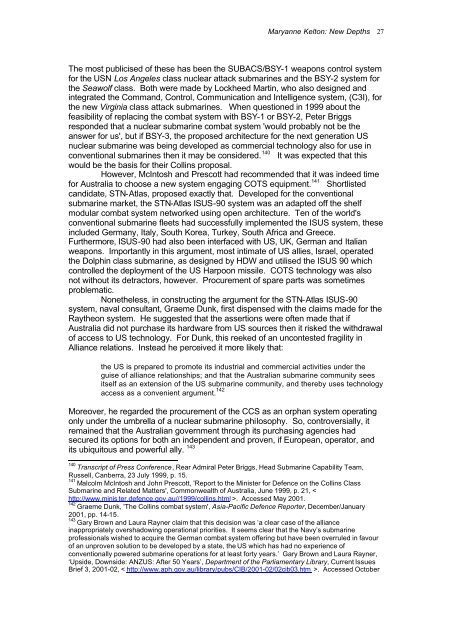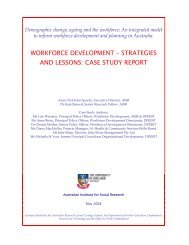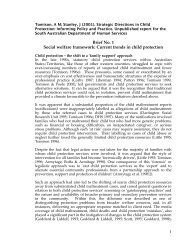New Depths in Australia-US Relations: The Collins Class ...
New Depths in Australia-US Relations: The Collins Class ...
New Depths in Australia-US Relations: The Collins Class ...
You also want an ePaper? Increase the reach of your titles
YUMPU automatically turns print PDFs into web optimized ePapers that Google loves.
Maryanne Kelton: <strong>New</strong> <strong>Depths</strong> 27<strong>The</strong> most publicised of these has been the SUBACS/BSY-1 weapons control systemfor the <strong>US</strong>N Los Angeles class nuclear attack submar<strong>in</strong>es and the BSY-2 system forthe Seawolf class. Both were made by Lockheed Mart<strong>in</strong>, who also designed and<strong>in</strong>tegrated the Command, Control, Communication and Intelligence system, (C3I), forthe new Virg<strong>in</strong>ia class attack submar<strong>in</strong>es. When questioned <strong>in</strong> 1999 about thefeasibility of replac<strong>in</strong>g the combat system with BSY-1 or BSY-2, Peter Briggsresponded that a nuclear submar<strong>in</strong>e combat system 'would probably not be theanswer for us', but if BSY-3, the proposed architecture for the next generation <strong>US</strong>nuclear submar<strong>in</strong>e was be<strong>in</strong>g developed as commercial technology also for use <strong>in</strong>conventional submar<strong>in</strong>es then it may be considered. 140 It was expected that thiswould be the basis for their Coll<strong>in</strong>s proposal.However, McIntosh and Prescott had recommended that it was <strong>in</strong>deed timefor <strong>Australia</strong> to choose a new system engag<strong>in</strong>g COTS equipment. 141 Shortlistedcandidate, STN-Atlas, proposed exactly that. Developed for the conventionalsubmar<strong>in</strong>e market, the STN-Atlas IS<strong>US</strong>-90 system was an adapted off the shelfmodular combat system networked us<strong>in</strong>g open architecture. Ten of the world'sconventional submar<strong>in</strong>e fleets had successfully implemented the IS<strong>US</strong> system, these<strong>in</strong>cluded Germany, Italy, South Korea, Turkey, South Africa and Greece.Furthermore, IS<strong>US</strong>-90 had also been <strong>in</strong>terfaced with <strong>US</strong>, UK, German and Italianweapons. Importantly <strong>in</strong> this argument, most <strong>in</strong>timate of <strong>US</strong> allies, Israel, operatedthe Dolph<strong>in</strong> class submar<strong>in</strong>e, as designed by HDW and utilised the IS<strong>US</strong> 90 whichcontrolled the deployment of the <strong>US</strong> Harpoon missile. COTS technology was alsonot without its detractors, however. Procurement of spare parts was sometimesproblematic.Nonetheless, <strong>in</strong> construct<strong>in</strong>g the argument for the STN-Atlas IS<strong>US</strong>-90system, naval consultant, Graeme Dunk, first dispensed with the claims made for theRaytheon system. He suggested that the assertions were often made that if<strong>Australia</strong> did not purchase its hardware from <strong>US</strong> sources then it risked the withdrawalof access to <strong>US</strong> technology. For Dunk, this reeked of an uncontested fragility <strong>in</strong>Alliance relations. Instead he perceived it more likely that:the <strong>US</strong> is prepared to promote its <strong>in</strong>dustrial and commercial activities under theguise of alliance relationships; and that the <strong>Australia</strong>n submar<strong>in</strong>e community seesitself as an extension of the <strong>US</strong> submar<strong>in</strong>e community, and thereby uses technologyaccess as a convenient argument. 142Moreover, he regarded the procurement of the CCS as an orphan system operat<strong>in</strong>gonly under the umbrella of a nuclear submar<strong>in</strong>e philosophy. So, controversially, itrema<strong>in</strong>ed that the <strong>Australia</strong>n government through its purchas<strong>in</strong>g agencies hadsecured its options for both an <strong>in</strong>dependent and proven, if European, operator, andits ubiquitous and powerful ally. 143140 Transcript of Press Conference, Rear Admiral Peter Briggs, Head Submar<strong>in</strong>e Capability Team,Russell, Canberra, 23 July 1999, p. 15.141 Malcolm McIntosh and John Prescott, 'Report to the M<strong>in</strong>ister for Defence on the Coll<strong>in</strong>s <strong>Class</strong>Submar<strong>in</strong>e and Related Matters', Commonwealth of <strong>Australia</strong>, June 1999, p. 21, . Accessed May 2001.142 Graeme Dunk, '<strong>The</strong> Coll<strong>in</strong>s combat system', Asia-Pacific Defence Reporter, December/January2001, pp. 14-15.143 Gary Brown and Laura Rayner claim that this decision was ‘a clear case of the alliance<strong>in</strong>appropriately overshadow<strong>in</strong>g operational priorities. It seems clear that the Navy’s submar<strong>in</strong>eprofessionals wished to acquire the German combat system offer<strong>in</strong>g but have been overruled <strong>in</strong> favourof an unproven solution to be developed by a state, the <strong>US</strong> which has had no experience ofconventionally powered submar<strong>in</strong>e operations for at least forty years.’ Gary Brown and Laura Rayner,‘Upside, Downside: ANZ<strong>US</strong>: After 50 Years’, Department of the Parliamentary Library, Current IssuesBrief 3, 2001-02, < http://www.aph.gov.au/library/pubs/CIB/2001-02/02cib03.htm >. Accessed October
















